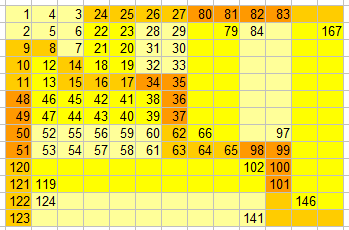The highest I have gotten without the aid of a computer is:
397
Solution:
1 ,2 ,1 ,177 ,397
3 ,2 ,101 ,176 ,220
3 ,5 ,98 ,75 ,44
8 ,5 ,18 ,31 ,44
8 ,13 ,13 ,13 ,13
Order of input:
1 ,3 ,2 ,23 ,25
5 ,4 ,21 ,21 ,24
6 ,7 ,20 ,19 ,18
9 ,8 ,13 ,15 ,17
10 ,11 ,12 ,14 ,16
Strategy:
Have to start with a 1,2,1 combination of some sort just to get the ball rolling. I figured it's best to get one of the 1s in a corner, out of the way. Then snaking down the left side allowed me to keep the 5 next to the centre square. As I then snaked across the bottom I realised the mistake in my first attempt was to not keep the 31 near the middle. So I changed this and continued to work around the edge. This time instead of going all the way up the right side, I moved into the middle. This allowed for a greater number to finish in the top-right.
First Attempt:
209
1 , 2 , 1 , 166 , 49
3 , 2 , 119 , 116 , 49
3 , 5 , 209 , 67 , 49
8 , 5 , 18 , 18 , 49
8 , 13 , 13 , 31 , 31
Order of input:
1 ,3 ,2 ,23 ,22
5 ,4 ,24 ,21 ,20
6 ,7 ,25 ,19 ,18
9 ,8 ,13 ,14 ,17
10 ,11 ,12 ,15 ,16
My strategy here was to try and work towards finishing on the centre cell, so I tried to keep the larger numbers towards the middle.

